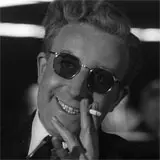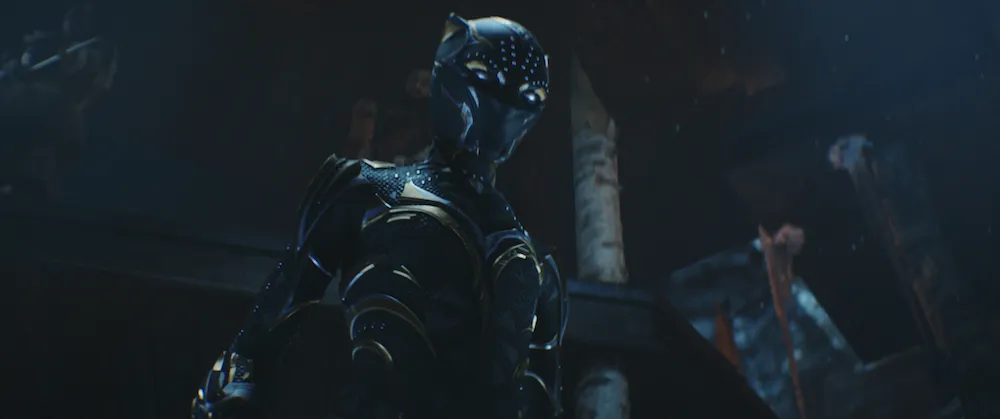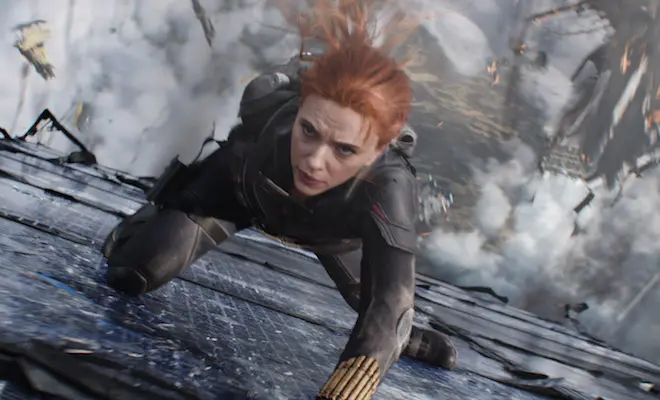 A half century has passed since the Cold War between the United States and the Soviet Union commenced, keeping the world under the constant threat of a nuclear holocaust. While Russia may no longer be the “Nuclear Boogeyman” it once was, the specter of someone using nuclear missiles, bombs and other weapons of mass destruction still looms large. This constant global threat is just one of the reasons why that after 45 years, Stanley Kubrick’s Dr. Strangelove: Or How I Stopped Worrying and Learned to Love the Bomb is still a film that dazzles, entertains and maintains its surprising degree of tension.
A half century has passed since the Cold War between the United States and the Soviet Union commenced, keeping the world under the constant threat of a nuclear holocaust. While Russia may no longer be the “Nuclear Boogeyman” it once was, the specter of someone using nuclear missiles, bombs and other weapons of mass destruction still looms large. This constant global threat is just one of the reasons why that after 45 years, Stanley Kubrick’s Dr. Strangelove: Or How I Stopped Worrying and Learned to Love the Bomb is still a film that dazzles, entertains and maintains its surprising degree of tension.
Based on the novel Red Alert, Strangelove tells the tale of a nuclear war started by a rather delusional Brigadier General named Jack D. Ripper (Sterling Hayden). Ripper believes that Communist Russia is planning an attack on America in order to drain its citizens of their precious bodily fluids (through fluoridated water, no less). Ripper proceeds to seal off his Air Force Base, terminate all communications with the outside world and orders B-52 bombers to carry out “Plan R,” an operation which allows a senior official to order a retaliatory strike against an enemy in the event that all of the heads of the American Government, including the President, have been killed.
Word of Ripper’s actions eventually reaches Washington D.C. Joint Chief of Staff “Buck” Turgidson (George C. Scott), where he briefs President Muffley (Peter Sellers) and his staff, including former Nazi scientist Dr. Strangelove (Sellers). Unable to contact Ripper, Turgidson suggests that instead of trying to avert an attack, perhaps it would be for the best if they follow through in the hopes of minimizing American casualties. The President, thinking otherwise, attempts to work out a more peaceful resolution, first by telling a rather pissed-off Soviet Ambassador and then a drunken Soviet premiere – via a phone call – that the whole thing was a “silly mistake” and then by giving the Soviets necessary information to shoot the planes down.
When British RAF Captain Lionel Mandrake (Sellers), Ripper’s former hostage and Second-In-Command, manages to get through to Washington with the recall code, the bombers head back home. That is except for one that is captained by Major T.J. “King” Kong (Slim Pickens) as the communications system on his plane has been damaged. If Kong’s bomber reaches its intended target, it will prove catastrophic in more ways than one. In addition to the obvious destruction and aftermath, the bombing will also trigger the Doomsday Machine, a top-secret Soviet device capable of wiping out all life on Earth.
Comedy, be it light or dark, is neither pretty nor easy. Satire, especially when it is of a political nature, can be outright difficult. In order for one to work, a satire needs a few crucial elements to be in place: a competent director, a great ensemble cast and a sly, incisive screenplay that is equal parts comedy, drama, and relevancy. If the combo works out, you get Three Kings, Network or Bulworth. If not, you get something along the lines of 1983’s Deal of the Century.
Obviously, Strangelove achieved this perfect balance and more. Kubrick started working on the film with the intention of making it a deadly serious drama. But the more he wrote, the more he saw of the absurdity inherent in the subject matter, which no doubt helped in creating the film’s underlying theme tying male sexual inadequacy to war. Despite the shift in overall tone, Kubrick and co-screenwriters Terry Southern and Peter George still kept a decent amount of the project’s original dramatic intentions in check. Like Kubrick, Sellers, Hayden, Scott and the rest of the extraordinary cast saw, understood and perfectly managed that delicate balance between the silly and the serious.
Even if the threat of nuclear war still did not hang over our head like the Sword of Damocles, Dr. Strangelove would still be considered one of the all-time great motion pictures, one of the very best from a filmmaker who has a rather amazing oeuvre. Sharply written, directed and acted, Strangelove will have you howling with laughter throughout. That is when you are not feeling uneasy that most of this still could come true.
Since Sony Pictures Home Entertainment has released Dr. Strangelove in every conceivable home video format known to man, it was only a matter of time before the movie made its Blu-ray debut. That time has arrived, with a premiere release that comes very close to being the ultimate edition of the 1964 classic. The disc comes housed in a digibook type of case that Warner occasionally uses on their catalog titles, containing roughly 36 pages of production notes, script pages, cast and crew biographies and essays.
The film underwent a 4K restoration a short time back, and the new 1080p/AVC-encoded transfer proudly displays the end result. Aside from a couple of scenes that feel a bit flat (ones located inside the bomber), I find it difficult to think that any fan of the movie would be disappointed with what they see here. A majority of the dirt, scratches and nicks that have plagued the previous home video editions have been removed, resulting in a clean picture with improved picture detail and some truly deep black levels. And cineastes rejoice; film grain makes its presence known from start to finish.
As many know, Kubrick shot the movie using two aspect ratios: 1.66:1 and 1.33:1. Many of the home video editions in the past have presented the movie using these two ratios. For this release, however, the 1.78:1 aspect ratio was chosen. While some may balk at this compromised ratio, I am happy to report that at no time does the picture look cropped, cramped or awkward. Stanley would surely approve.
The film’s audio has also received a bit of reworking, which isn’t necessarily a bad thing. As we all know, a majority of the 5.1 surround upgrades on films made prior to the age of Dolby Digital have been anything but spectacular. In fact, many just plain suck. They sound gimmicky and become a major distraction when watching a film. Two prime examples are The Wild Bunch and The Good, The Bad and the Ugly.
Fortunately, the 5.1 Dolby TrueHD track for Strangelove does not try to take the original monaural tracks and turn them into a six-channel aural assault. The sound is regulated mostly to the front speakers. If there was any surround activity happening, I was unaware of it. The center-channel dialogue is surprisingly clear given the film’s age, as are the left and right front speaker delivery of the occasional music cue. TrueHD’s use of the LFE channel is sparse, but when it does come into play, it too is nicely handled. Unfortunately, as was the case with Wild Bunch and Good, Bad and Ugly, effects such as gunfire come across sounding tinny and distracting. For purists who want the sound as it originally was presented, there is an, ahem, “fail safe” audio option to choose from: a restored monaural track that sounds just fine.
The supplements found on the 45th Anniversary edition contain many of the bonuses from previous DVD editions, with one glaring omission and a nice BD exclusive thrown into the mix. Overall, Sony has assembled a strong series of extras that look not only at the film’s production, but also the historical events that gripped the world at the time of the movie’s production and release. All the recent video-based extras are presented in pretty nice-looking 480p Standard Definition video:
The Cold War: This is a very thorough picture-in-picture feature that offers up plenty of information on Cold War adversaries America and Russia, as well as tidbits on the production of the movie. Aside from the popup text, there are also video interviews sprinkled throughout that appear in the form of old-time television snippets.
Inside Dr. Strangelove: Or How I Stopped Worrying and Learned To Love the Bomb: This 46-minute documentary from 2000 is exactly what you would expect it to be: a retrospective look at the production of the movie and features input from many of the remaining (at the time of production) cast and crew members, including producer James B. Harris, production designer Ken Adam, cinematographer Gilbert Taylor and actor James Earl Jones. It is a solid documentary to be sure, but one that should have ditched the narrator. His delivery is completely wrong for the tone.
No Fighting in the War Room, or Dr. Strangelove and the Nuclear Threat: Running thirty minutes, this enjoyable 2004 feature offers insight from critic Roger Ebert, filmmaker Spike Lee, journalist Bob Woodward and the recently-deceased former Secretary of Defense Robert McNamara among others. Each offers up insightful views on the film’s characters, themes, satire and legacy.
Best Sellers, or Peter Sellers and Dr. Strangelove: A 19-minute look at the late actor’s life and work that features interviews with Michael Palin, Shirley MacLaine, director Richard Lester, Sir David Frost, Spike Lee and Roger Ebert. While most of this feature covers, obviously, Strangelove, we are also given some rare glimpses into Sellers private life via a few home movies and audio recordings.
The Art of Stanley Kubrick- From Short Films to Strangelove: A brief (14 minutes) chronicle of the late filmmaker’s beginnings, starting with his photography stint for Look magazine in the 1940s right up to the making of his 1964 masterpiece.
An Interview with Robert McNamara: An interesting but relatively brief 24-minute interview with President Kennedy’s Secretary of Defense, this segment has Mr. McNamara giving recollections and thoughts on events of the Cold War as well as more recent events. If you like what you see here, I strongly recommend checking out Errol Morris’ The Fog of War.
Split-screen Interviews: Man, this was strange. To promote the film when it was hitting theaters in 1964, Columbia Pictures shot interviews with George C. Scott and Peter Sellers (in his President makeup) as if they were on the phone. Now, that is not the odd part. The strange thing here is that when Scott is being interviewed, it only takes up half the screen. The same goes for Sellers (although part of his interview goes full screen). Despite the title card present at the front of this seven-minute promo piece, I am still not sure why it was presented this way.
So what is missing from the set that should have been included without question? Well, the film’s theatrical trailer is missing. Anyone who has seen this preview knows that it is one of the best – and most bizarre – trailers ever produced to sell a movie. If the trailer can make its way up onto YouTube and other sites across the Internet, why the hell can it not make its way onto an Anniversary edition released by the studio that produced the movie?! This makes about as much sense as the Soviets making a Doomsday device and keeping it a secret.
With our good friends Kim Jong Il of North Korea and Iranian President Mahmoud Ahmadinejad waving around their respective country’s nuclear weapon capability like it were a new car (or an extension of their manhood), perhaps there is no better time for Dr. Strangelove to make its Blu-ray debut. The film speaks for itself, and the 45th Anniversary edition Blu-ray is a winner as well. Whether you have never seen the film or have seen it enough times that you can impersonate Sellers’ German accent flawlessly, this disc should be mandatory in terms of ownership.
-Shawn Fitzgerald


